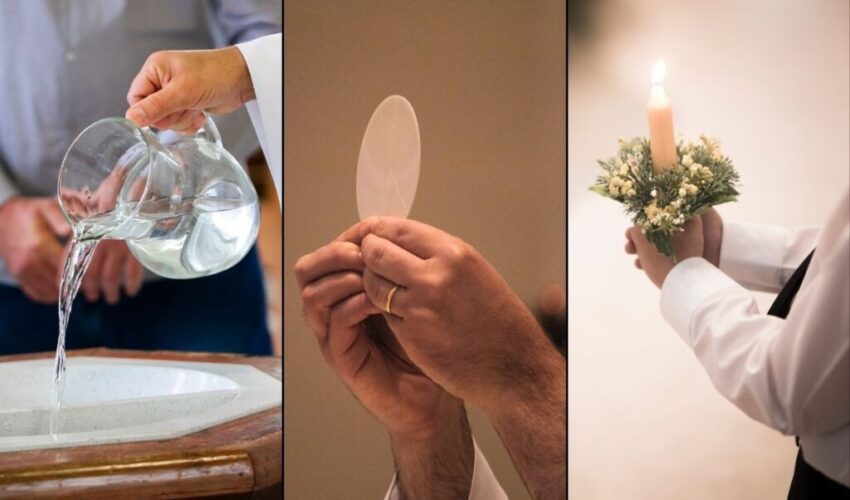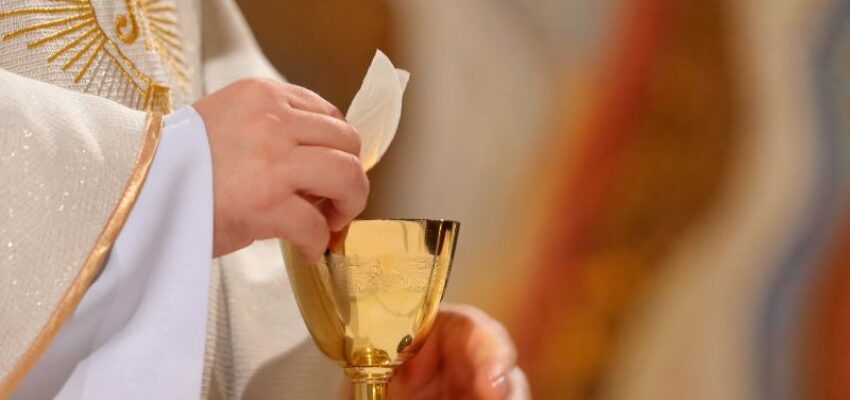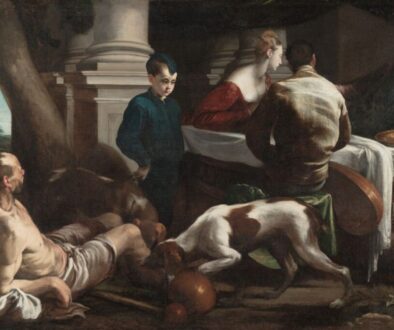What’s The Difference Between Baptism, Communion, and Confirmation?

Published September 22, 2023
Baptism, communion, and confirmation are three of the seven sacraments in Catholicism. They’re typically the first three sacraments that Catholics receive. So if you grew up Catholic, you’ve probably gone through all these sacraments.
However, those new to the faith might have a hard time understanding the difference between them. Even some Catholics struggle to figure out their significance and how they differ.
No worries. That’s what this post is about. Here’s a quick guide to these sacraments and how they differ.
But first, let’s refresh our knowledge of the seven sacraments.
The Significance of the Sacraments
In Catholic catechism, sacraments are defined as the outward signs of inward grace. They are instituted by Christ himself to bring God’s grace closer to His people.
In other words, the sacraments are not just an expression of our faith in God. They also serve as an affirmation of our willingness to live and grow in His divine grace.
That’s why, in the Catholic faith, there are seven sacraments:
- baptism
- communion
- confirmation
- marriage
- ordination
- reconciliation or penance
- anointing of the sick
Each of these sacraments serves a different purpose and is celebrated with a specific rite. They also correspond with life events common to most people.
Catholics are also expected to receive most of these sacraments, especially baptism. However, some sacraments, like marriage and ordination, are optional.
Understanding Baptism, Communion, and Confirmation
As mentioned, baptism, confirmation, and communion are the first three sacraments Catholics receive – in that order. So you can think of them as initiation rites to welcome someone into the Catholic community.
But each of them serves a different purpose and involves specific rites. To help you understand them better, let’s take a closer look at what each sacrament signifies.
What is Baptism?
Baptism is the very first sacrament Catholics receive. It symbolizes a rebirth – the forgiveness and abrogation of your past sins so a new individual can emerge. It also marks the beginning of our life in Christ. Because of that, baptism is often considered the sacrament of admission to the faith.
As every Catholic knows, all of us are born with the weight of the original sin. By giving His life for us, Christ purchased for us eternal life (John 3:16).
Through baptism, we accept God’s grace into our lives and affirm our belief in Jesus as our savior. In doing so, we shed the taint of the original sin to start a new and eternal life in Him (John 3:36).
The Baptismal Rite
Catholic baptism is commonly administered to infants. But unbaptized adults who wish to convert to the faith must also receive the sacrament. A person can also only be baptized once.
Whether an infant or an adult, baptismal rites are typically performed at church, the priest will pour holy water on the head of the person being baptized while invoking the Holy Trinity.
The Catholic baptismal rite involves several significant rituals and actions. It begins with a welcome and opening prayer, followed by reading Scripture passages related to the meaning of baptism. The litany of saints is recited, invoking their intercession and support. In the case of adult baptism, there may be a prayer of exorcism and anointing with the oil of catechumens.
The baptized person or their godparents profess the Catholic faith and make baptismal promises. The central act of baptism involves the pouring or immersion of the person in the water. This symbolizes purification and initiation into the Christian community. An anointing with sacred chrism represents the seal of the Holy Spirit.
The newly baptized is clothed in a white garment, signifying purity and newness of life. A baptismal candle from the Paschal Candle symbolizes sharing in Christ’s light. The ceremony concludes with a final blessing and dismissal, celebrating the reception of a new member into the Church.
Instruction on Infant Baptism is a document that provides pastoral guidelines for infant baptism and discusses the preparation and celebration of the sacrament.
What is Confirmation?
As the name suggests, the Sacrament of Confirmation serves as a confirmation of an individual’s baptism. It “seals” that person’s membership in the Catholic church.
Given only to baptized Catholics, Confirmation strengthens the grace we received in baptism. It also serves to confer to the recipient the gifts of the Holy Spirit. All these deepen our personal relationship with God and confirm our calling to share His word and a witness to His greatness.
Not all baptized Catholics can receive this sacrament, though. The Catholic church requires one to be at least seven years old to go through the rite of confirmation.
The Confirmation Rite
The rite is usually performed by a bishop or a priest who lay their hands upon the recipient’s head in prayer and blessing. They’ll also anoint the recipient’s forehead with holy oil or chrism.
The Confirmation ceremony begins with prayers, hymns, and readings. These prepare the candidates for the sacrament. The candidates, usually adolescents or adults, publicly renew their baptismal promises. They reaffirm their commitment to living as followers of Christ.
The central ritual involves the bishop or priest touching each candidate’s head. He will then invoke the Holy Spirit and transmit spiritual power.
The candidates’ foreheads are anointed with sacred chrism. This symbolizes the seal of the Holy Spirit and marks their full initiation into the Church. A prayer of blessing is offered over the newly confirmed, invoking God’s grace and guidance. The exchange of the sign of peace signifies unity and reconciliation.
In some cases, Confirmation may be celebrated within the context of the Eucharistic celebration. This allows the newly confirmed to receive Holy Communion and deepen their participation in the life of the Church.
Code of Canon Law – Book IV – Function of the Church is a document that provides information on the sacrament of confirmation, its purpose, and its effects on the baptized.
What is Communion?
Also known as the Holy Eucharist, the Sacrament of Communion completes a believer’s initiation right. It’s a central rite to Catholic worship and has its origins in the Last Supper.
In the Catholic tradition, the Holy Eucharist serves two major purposes:
- an expression of our fellowship with God
- a commemoration of His life, death, and resurrection
Unlike the previous two sacraments that can only be received once, Communion can be received every day if desired. For baptized children, this sacrament is often first celebrated when they are about seven or eight years old.
The Rite of Communion
The Holy Eucharist is normally celebrated within a mass. During this, the priest or mass celebrant consecrates the bread and wine which represents the body and blood of Christ. That same consecrated bread is then shared with the faithful.
The Rite of Communion is a central part of the Catholic Mass. After the Liturgy of the Word, the faithful prepare themselves. They pray and reflect on the reception of the body and blood of Christ.
The priest consecrates the bread and wine during the Eucharistic Prayer. He then transforms them into the real presence of Christ. The priest receives Holy Communion, acknowledging his role as a mediator between God and the faithful. He then invites the congregation to come forward and receive the Eucharist.
The faithful affirm their belief in the real presence of Christ. They approach the altar and receive the consecrated host. This is done by consuming it immediately or sipping from the chalice if available.
After receiving Holy Communion, they engage in prayer and reflection. They commune personally with Christ and express thanksgiving for the mystery of the Eucharist.
Instruction Redemptionis Sacramentum is an instruction that focuses on various aspects of the liturgy, including the proper distribution of Holy Communion and guidelines for the celebration of the Eucharist.
How Do They Differ?
Based on the definitions above, baptism, communion, and confirmation differ in three ways:
- purpose
- rite
- when one can receive them
Purpose
The main purpose of baptism is to induct someone into the faith. While the sacrament of confirmation affirms their membership in the church. On the other hand, the sacrament of communion is an act of worship to affirm one’s willingness to commune with God.
Rite
The rite of baptism involves pouring water on the head of the one being baptized. While the confirmation rite uses holy oil or chrism to bless the recipient and the communion sacrament involves consecrated bread.
When One Can Receive Them
Most Catholics are baptized as infants, while confirmation can only be administered when one is at least seven years old. One cannot receive confirmation or communion if they haven’t yet been baptized.
(Related: What is an Act of Contrition?)

The Origins of Baptism, Confirmation, and Communion
The origins of baptism, confirmation, and communion can be traced back to the Bible. Here is a brief explanation of their origins:
Baptism
Baptism finds its roots in the New Testament, specifically with the ministry of John the Baptist. John preached a baptism of repentance and forgiveness of sins. This symbolized cleansing and preparation for the coming of Jesus Christ. Jesus Himself was baptized by John in the River Jordan, setting an example for his followers.
After His resurrection, Jesus commanded His disciples to baptize believers in the name of the Father, Son, and Holy Spirit (Matthew 28:19). The early Christian community continued the practice of baptism as a sacrament. It represents initiation into the faith and the forgiveness of sins.
Confirmation
The concept of confirmation is closely linked to the outpouring of the Holy Spirit as described in the New Testament. In Acts 2, on the day of Pentecost, the Holy Spirit descended upon the disciples, empowering them for their mission.
In the next passages, we see the laying on of hands by the apostles, which was accompanied by the receiving of the Holy Spirit. This laying on of hands became a common practice in the early Church to bestow the gifts of the Holy Spirit upon believers and confirm their faith.
Communion
The practice of communion is also known as the Lord’s Supper or Eucharist. It originates in the Last Supper shared by Jesus with His disciples.
During this Passover meal, Jesus took bread and wine and blessed them. He then gave them to His disciples, saying, “This is my body” and “This is my blood.” He instructed them to do this in remembrance of Him.
The early Christian community continued this practice. They gather together to partake in the bread and wine to remember and participate in Christ’s sacrifice.
Summing it Up
Baptism, communion, and confirmation are three important sacraments in the Catholic faith. Baptism symbolizes rebirth and admission into the faith. While confirmation confirms one’s baptism and deepens their relationship with God. Understanding the significance of these sacraments can help Catholics deepen their faith and connection with God.
Seek a Deeper Connection with God and Join Lay Cistercians of South Florida
Lay Cistercians of South Florida, is a community of lay people who seeks to have a deeper connection with God by living a life inspired by the monks and nuns through Lay Monasticism. Learn more about what is a Lay Cistercian on our website. Anyone who aspires to do the same as us, and is a confirmed Catholic is welcome to join us! We meet every second Saturday of the month at Emmanuel Catholic Church in Delray Beach, Florida.

This Content Has Been Reviewed For Accuracy
This content has undergone comprehensive fact-checking by our dedicated team of experts. Discover additional information about the rigorous editorial standards we adhere to on our website.

About The Author
Judy Ponio is a professional writer for the Lay Cistercians blog and a devoted Catholic. She works hard to ensure her work uses accurate facts by cross checking reputable sources.




